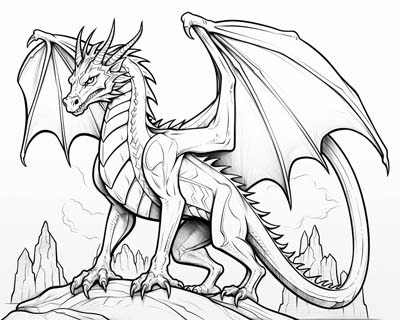Printable Coloring Pages
Celtic Dragon Coloring Pages
Join me on a mystical adventure with our collection of Celtic dragons coloring pages, where I invite you to breathe life into these legendary creatures with your palette of colors.
About Celtic dragons:
Brigid, also known as Brigit or Bridget, holds a significant place in Celtic mythology as a figure of immense versatility and reverence. Here's a concise overview of this esteemed deity:

In the rich tapestry of Celtic mythology, dragons hold a place of profound significance, embodying the very essence of power, magic, and mystery. Celtic dragons, often depicted intertwined in an endless knot in ancient stone carvings and illuminated manuscripts, represent the cyclical nature of life and the intertwining of the physical and spiritual worlds.
Imagine dragons with scales that shimmer in emerald greens and deep blues, reflecting the lush landscapes of the Celtic lands. Their eyes, like glowing jewels, could be sapphire blue or fiery amber, piercing through the mists of ancient forests. The breath of a Celtic dragon might be visualized as a burst of flame, tinged with the mystical hues of magic--purples and indigos that light up the darkened skies of old tales. These creatures often guarded sacred sites, their coiled forms and elaborate knotwork designs serving as gatekeepers to otherworldly realms, their colors blending with the natural elements they personified. In art, their bodies could be adorned with intricate patterns, mirroring the complex interlacings of Celtic knotwork, with each twist and turn in their design painted in vibrant hues that capture the imagination and invite storytellers to weave tales as colorful and enduring as the dragons themselves.
Celtic dragons held profound symbolic meaning and were central to numerous myths and legends in Celtic culture. These creatures weren't just fantastical beasts; they embodied various elements of the natural world, as well as intangible concepts such as power, wisdom, and the cyclical nature of life.
Symbolic Meanings
-
Power and Sovereignty: Dragons were often seen as symbols of power and might. Their presence in stories and imagery was used to represent the strength and authority of tribal leaders and chieftains. The association of dragons with power was so strong that they were often depicted alongside Celtic gods or as guardians of sacred places.
-
Wisdom and Prophecy: Due to their long lifespans and mythical abilities, dragons were also symbols of wisdom and prophecy in Celtic mythology. They were believed to possess knowledge beyond human understanding, including insights into the future and the hidden truths of the world.
-
Protection: Celtic dragons were frequently considered protectors. This role is evident in their depiction in architectural elements, where they were carved into the stone of ancient buildings and monuments to ward off evil spirits and bring protection to the site.
-
The Natural World: Dragons in Celtic mythology were deeply connected to the land and the forces of nature. They were often associated with the elements, particularly earth and water, and were believed to have control over the land's fertility and the well-being of the kingdom.














